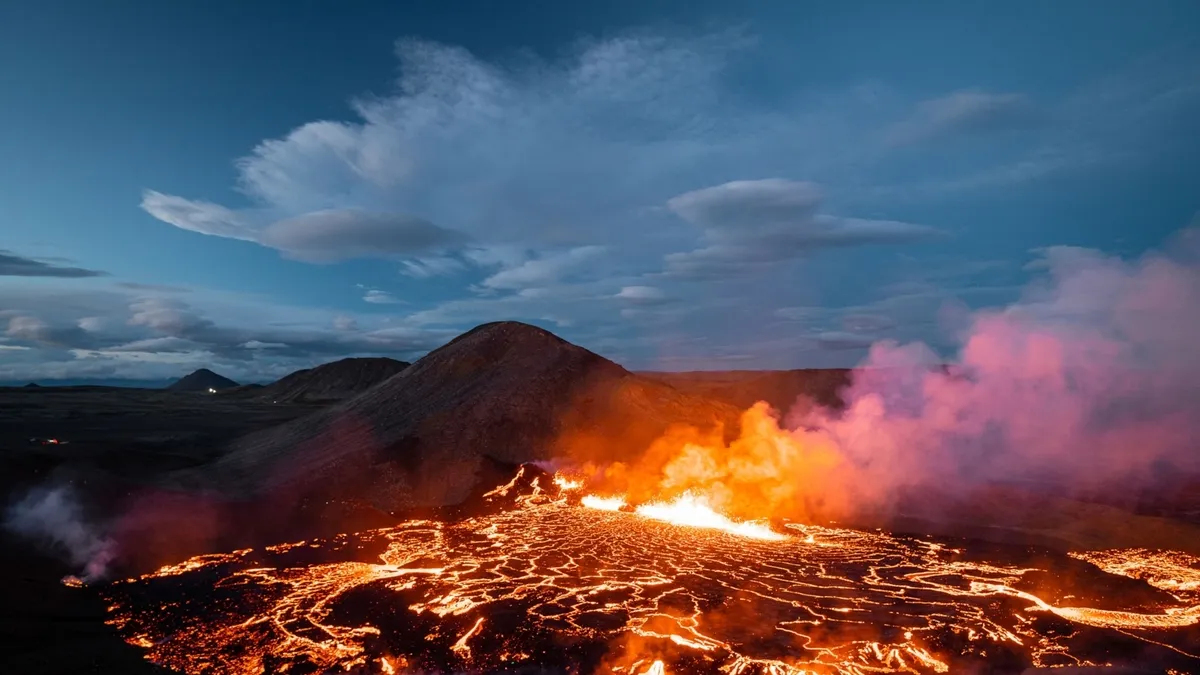In November of last year, after detecting a flow of moving magma stretching nine miles long under Grindavík, a fishing village in southwest Iceland’s Reykjanes Peninsula, officials ordered an evacuation of at least 3,000 people living in the area. Although the evacuation took place as a preventative measure, not because citizens were in immediate danger, seismologists have recorded a total of at least 24,000 earthquakes just within the previous days leading up to the evacuation order. The official reasoning for the order, officials later announced, was an increase in sulfur dioxide (SO2) values in the air. Over the subsequent four months, from December 18 to March 17, volcanic eruptions have freed a flow of lava, only narrowly avoiding Grindavík.
One major worry regarding the movement of magma is that it will reach the ocean. In that case, the original temperature of the magma, combined with the drastic and quick change in temperature once it reaches the water, would create many large explosions that have the potential to cause major damage to the surrounding town. Even before the eruptions began, Grindavík had already seen some damage, with roads and sidewalks disconnected due to underground magma movement that forces cracks at the surface of the Earth.
Another concern is destruction to energy resources. To protect the Svartsengi Geothermal Power Plant, a significant power plant close to the town, authorities dug a trench to prevent lava from reaching the plant and causing outages. As of Monday, November 13th, the greatest amount of magma, closest to the surface, was about two miles northeast of Grindavík. As many scientists at the time pointed out, there was no certain way of knowing whether the magma would reach the surface, as it ultimately did, knowing whether it would reach the town, or of foreseeing the severity of the ensuing eruptions. Volcanic activity can be nearly impossible to predict, which is what makes it so dangerous.
Toxic fumes add to the dangers as well, as they can cause breathing problems both in the short term and the long term. People with asthma and those with chronic respiratory conditions are especially vulnerable. A massive plume of sulfur dioxide from the eruptions is, at present, drifting across the European continent, though atmospheric monitors do not anticipate a significant effect on weather or health.
The recent events raise the question of whether the volcanoes recent eruptions are somehow related to the issue of global warming or possibly other environmental issues the world has been facing. Although the answer to this question seems to be almost impossible to answer confidently, the timing of the volcanic activity in Iceland, given that it occurred about a year after the eruption in Hawaii and around the same time as other eruptions in countries such as Italy and Japan, might seem to hint at a connection. According to experts in vulcanology, however, including the Global Volcanism Program, there is no robust evidence that “that volcanic activity is actually increasing.” Volcanologists instead point to increased media coverage as volcanoes erupt near populated areas.
Regardless, Iceland is no stranger to volcanoes. The last time this particular volcano erupted was in 2010, over a decade ago, although the eruption in 2010 was a much larger affair and more serious than what seems to be taking place now. Overall, the country has 32 active volcanoes, with the previous eruption occurring in 2021, and one prior to that in 2014. The reasoning behind this is being the fact that the country sits on a major tectonic plate divergent boundary between North America and Eurasia, otherwise known as the Mid-Atlantic Ridge.
The eruption of the volcano may appear entirely unrelated to politics within the country. The reality is quite the opposite. In a region where natural disasters such as volcanic eruptions pose grave threats to the population, politicians’ stances on response efforts and economic questions begin to matter a great deal. Citizens want to know that in the case of an eruption, they will be represented and taken care of by the politicians who represent them and that their governmental institutions will provide for them in disastrous times. These notions are sure to affect who is elected into office in Iceland, and what policies are enacted within both the country and smaller towns such as Grindavík.
Another issue with the eruption is the threat it poses to tourism in the country. Particularly bad eruptions have the potential to prevent flights into the country and, in turn, prevent tourists from arriving and staying in the country. Luckily for Iceland, this eruption seems not to have posed a great threat to tourism. Instead, the volcanoes may actually be boosting tourism, as tourists seek the opportunity to witness what one visitor called a “once-in-a-lifetime” event. Hence, since foreign governments have deemed it safe to travel to Iceland, many travelers from around the world have flown into the country to watch the eruption.
It’s difficult to ascertain exactly how the future will unfold for this small fishing town and Iceland as a whole simply due to the volatile nature of volcanic eruptions. However, scientists have remained optimistic since the beginning of these events, and seem to think that this will end up being a minor case of volcanic activity when it’s all over. Indeed, a professor of volcanology at the University of Iceland has suggested that the eruptions near Grindavík are drawing to a close. But one thing remains evidently clear to scientists: Iceland will remain the hot spot of volcanic activity for at least the next couple of generations.
Featured Image Source: National Geographic






Comments are closed.